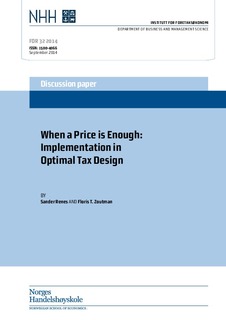When a price is enough : implementation in optimal tax design
Working paper
Permanent lenke
http://hdl.handle.net/11250/223701Utgivelsesdato
2014-09Metadata
Vis full innførselSamlinger
- Discussion papers (FOR) [566]
Sammendrag
This paper studies the design of tax systems that implement a planner's secondbest
allocation in a market economy. An example shows that the widely used Mirrleesian
(1976) tax system cannot implement all incentive-compatible allocations.
Hammond's (1979) "principle of taxation" proves that any incentive-compatible
allocation can be implemented through at least one tax system. However, this tax
system is often undesirable since it severely restricts the choice space of agents in
the economy. In this paper we derive necessary and suficient conditions to verify
whether a given tax system can implement a given incentive-compatible allocation.
We show that when an incentive-compatible allocation is on the Pareto frontier,
and/or surjective onto the choice space, a tax system that equates the marginal
tax rates to the optimal wedges can implement the second best, without restricting
the choice space of the agents. It follows that the Mirrleesian tax system can
successfully implement the second best in the identified classes. Since the secondbest
allocation of welfarist planners is always on the Pareto frontier, our results (ex
post) validate most tax systems proposed in the literature. Outside of the identified
classes, the planner may need to restrict the choice space of agents to implement its
second best in the market. This sheds new light on rules, quotas and prohibitions
used in real-world tax and benefit systems.
